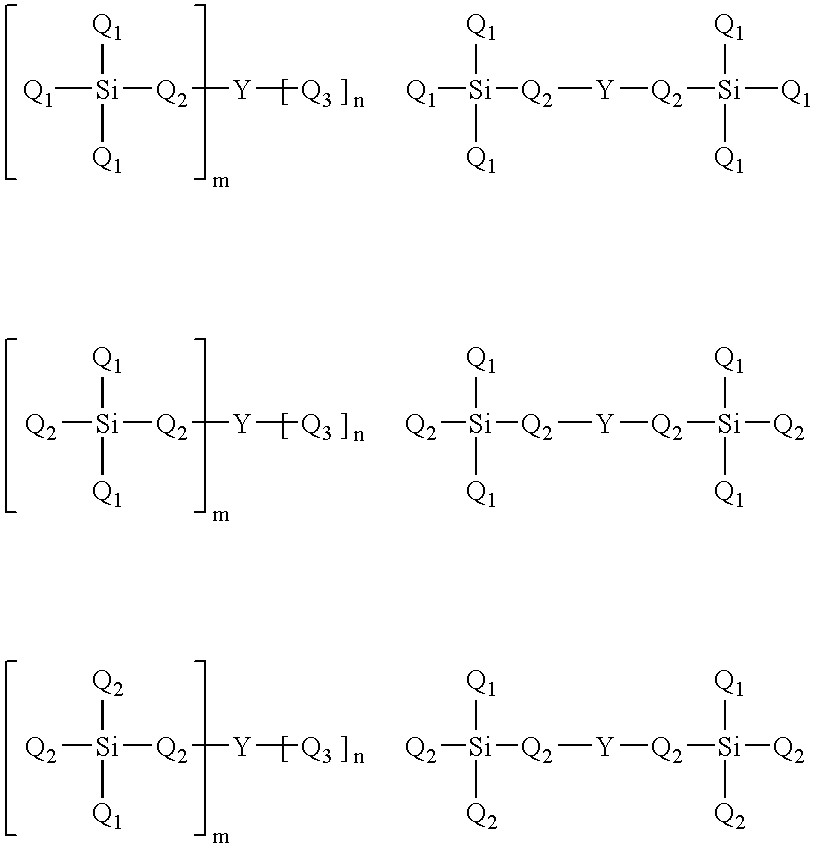Cross-linked nitric oxide-releasing polyamine coated substrates, compositions comprising same and method of making same
a technology of nitric oxide and polyamine, which is applied in the direction of prosthesis, packaging foodtuffs, packaged goods, etc., can solve the problems of compromising the blood flow to the heart muscle, affecting the quality of life of patients, and carries with it appreciable morbidity and mortality risks
- Summary
- Abstract
- Description
- Claims
- Application Information
AI Technical Summary
Problems solved by technology
Method used
Image
Examples
example 1
[0066] This example illustrates the preparation of a diazeniumdiolated substituted ammonium 1-aminopropylsiloxane-5-PEI-2,4-dinitrobenzene-coated stainless steel coupon.
[0067] A 1×1 cm sheet of medical-grade stainless steel was placed in a 13×100 mm test tube containing a neat solution of 3-aminopropyltrimethoxysilane. After 3 minutes of exposure, excess silane reagent was removed. The coupon was washed with methanol and diethyl ether, and dried under nitrogen for several minutes until the residual solvent had completely evaporated. The test tube containing the coupon was placed in an oven at 110° C. for 15 minutes. The test tube was removed from the oven and allowed to cool to room temperature.
[0068] The coupon was transferred to a new test tube and 2 mL of a tetrahydrofuran (THE) solution containing 40 mg of 1,5-difluoro-2,4-dinitrobenzene and 20 mg of anhydrous potassium carbonate was added. Using a hot air dryer, the test tube was then carefully heated until the solution began...
example 2
[0071] This example illustrates the preparation of a 1-aminopropylsiloxane-5-methoxymethyl-protected monodiazeniumdiolate of piperazine-2,4-dinitrobenzene-coated stainless steel coupon.
[0072] Per the method outlined above, 100 mg of a methoxymethyl-protected monodiazeniumdiolate of piperazine derivative was coupled to the surface of a 1-aminopropylsiloxane-5-fluoro-2,4-dinitrobenzene-coated metal coupon. When immersed in a 1.0 M phosphate buffer, pH 7.4 at 37° C., chemiluminescence-detectable NO was evolved at a negligible initial rate. After 15 minutes, 1 mL of a 25% sulfuric acid solution was added, whereupon 551 pmoles of NO was detected over a period of 2.26 h.
PUM
| Property | Measurement | Unit |
|---|---|---|
| Concentration | aaaaa | aaaaa |
| Molecular weight | aaaaa | aaaaa |
| Metallic bond | aaaaa | aaaaa |
Abstract
Description
Claims
Application Information
 Login to View More
Login to View More - R&D
- Intellectual Property
- Life Sciences
- Materials
- Tech Scout
- Unparalleled Data Quality
- Higher Quality Content
- 60% Fewer Hallucinations
Browse by: Latest US Patents, China's latest patents, Technical Efficacy Thesaurus, Application Domain, Technology Topic, Popular Technical Reports.
© 2025 PatSnap. All rights reserved.Legal|Privacy policy|Modern Slavery Act Transparency Statement|Sitemap|About US| Contact US: help@patsnap.com



